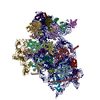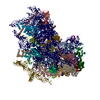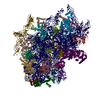[English] 日本語
 Yorodumi
Yorodumi- PDB-7syx: Structure of the delta dII IRES eIF5B-containing 48S initiation c... -
+ Open data
Open data
- Basic information
Basic information
| Entry | Database: PDB / ID: 7syx | ||||||||||||
|---|---|---|---|---|---|---|---|---|---|---|---|---|---|
| Title | Structure of the delta dII IRES eIF5B-containing 48S initiation complex, closed conformation. Structure 15(delta dII) | ||||||||||||
 Components Components |
| ||||||||||||
 Keywords Keywords | RIBOSOME / HCV / IRES / 40S | ||||||||||||
| Function / homology |  Function and homology information Function and homology informationmulti-eIF complex / eukaryotic 43S preinitiation complex / translation factor activity, RNA binding / eukaryotic 48S preinitiation complex / ribosomal subunit / protein-synthesizing GTPase / Formation of the ternary complex, and subsequently, the 43S complex / laminin receptor activity / Ribosomal scanning and start codon recognition / Translation initiation complex formation ...multi-eIF complex / eukaryotic 43S preinitiation complex / translation factor activity, RNA binding / eukaryotic 48S preinitiation complex / ribosomal subunit / protein-synthesizing GTPase / Formation of the ternary complex, and subsequently, the 43S complex / laminin receptor activity / Ribosomal scanning and start codon recognition / Translation initiation complex formation / Formation of a pool of free 40S subunits / ubiquitin ligase inhibitor activity / positive regulation of signal transduction by p53 class mediator / GTP hydrolysis and joining of the 60S ribosomal subunit / 90S preribosome / L13a-mediated translational silencing of Ceruloplasmin expression / phagocytic cup / laminin binding / ribosomal small subunit export from nucleus / rough endoplasmic reticulum / translation regulator activity / gastrulation / MDM2/MDM4 family protein binding / translation initiation factor activity / cytosolic ribosome / class I DNA-(apurinic or apyrimidinic site) endonuclease activity / DNA-(apurinic or apyrimidinic site) lyase / positive regulation of apoptotic signaling pathway / maturation of SSU-rRNA from tricistronic rRNA transcript (SSU-rRNA, 5.8S rRNA, LSU-rRNA) / ribosome assembly / maturation of SSU-rRNA / small-subunit processome / translational initiation / spindle / rRNA processing / rhythmic process / positive regulation of canonical Wnt signaling pathway / regulation of translation / ribosome binding / virus receptor activity / ribosomal small subunit biogenesis / ribosomal small subunit assembly / small ribosomal subunit / small ribosomal subunit rRNA binding / cytosolic small ribosomal subunit / perikaryon / cytoplasmic translation / cell differentiation / tRNA binding / mitochondrial inner membrane / postsynaptic density / rRNA binding / structural constituent of ribosome / ribosome / translation / ribonucleoprotein complex / cell division / DNA repair / GTPase activity / mRNA binding / apoptotic process / synapse / dendrite / centrosome / GTP binding / nucleolus / perinuclear region of cytoplasm / Golgi apparatus / mitochondrion / DNA binding / RNA binding / zinc ion binding / metal ion binding / nucleus / membrane / plasma membrane / cytoplasm / cytosol Similarity search - Function | ||||||||||||
| Biological species |  Homo sapiens (human) Homo sapiens (human) Hepatitis C virus Hepatitis C virus | ||||||||||||
| Method | ELECTRON MICROSCOPY / single particle reconstruction / cryo EM / Resolution: 3.7 Å | ||||||||||||
 Authors Authors | Brown, Z.P. / Abaeva, I.S. / De, S. / Hellen, C.U.T. / Pestova, T.V. / Frank, J. | ||||||||||||
| Funding support |  United States, 3items United States, 3items
| ||||||||||||
 Citation Citation |  Journal: EMBO J / Year: 2022 Journal: EMBO J / Year: 2022Title: Molecular architecture of 40S translation initiation complexes on the hepatitis C virus IRES. Authors: Zuben P Brown / Irina S Abaeva / Swastik De / Christopher U T Hellen / Tatyana V Pestova / Joachim Frank /  Abstract: Hepatitis C virus mRNA contains an internal ribosome entry site (IRES) that mediates end-independent translation initiation, requiring a subset of eukaryotic initiation factors (eIFs). Biochemical ...Hepatitis C virus mRNA contains an internal ribosome entry site (IRES) that mediates end-independent translation initiation, requiring a subset of eukaryotic initiation factors (eIFs). Biochemical studies revealed that direct binding of the IRES to the 40S ribosomal subunit places the initiation codon into the P site, where it base pairs with eIF2-bound Met-tRNAiMet forming a 48S initiation complex. Subsequently, eIF5 and eIF5B mediate subunit joining, yielding an elongation-competent 80S ribosome. Initiation can also proceed without eIF2, in which case Met-tRNAiMet is recruited directly by eIF5B. However, the structures of initiation complexes assembled on the HCV IRES, the transitions between different states, and the accompanying conformational changes have remained unknown. To fill these gaps, we now obtained cryo-EM structures of IRES initiation complexes, at resolutions up to 3.5 Å, that cover all major stages from the initial ribosomal association, through eIF2-containing 48S initiation complexes, to eIF5B-containing complexes immediately prior to subunit joining. These structures provide insights into the dynamic network of 40S/IRES contacts, highlight the role of IRES domain II, and reveal conformational changes that occur during the transition from eIF2- to eIF5B-containing 48S complexes and prepare them for subunit joining. | ||||||||||||
| History |
|
- Structure visualization
Structure visualization
| Structure viewer | Molecule:  Molmil Molmil Jmol/JSmol Jmol/JSmol |
|---|
- Downloads & links
Downloads & links
- Download
Download
| PDBx/mmCIF format |  7syx.cif.gz 7syx.cif.gz | 1.9 MB | Display |  PDBx/mmCIF format PDBx/mmCIF format |
|---|---|---|---|---|
| PDB format |  pdb7syx.ent.gz pdb7syx.ent.gz | 1.5 MB | Display |  PDB format PDB format |
| PDBx/mmJSON format |  7syx.json.gz 7syx.json.gz | Tree view |  PDBx/mmJSON format PDBx/mmJSON format | |
| Others |  Other downloads Other downloads |
-Validation report
| Arichive directory |  https://data.pdbj.org/pub/pdb/validation_reports/sy/7syx https://data.pdbj.org/pub/pdb/validation_reports/sy/7syx ftp://data.pdbj.org/pub/pdb/validation_reports/sy/7syx ftp://data.pdbj.org/pub/pdb/validation_reports/sy/7syx | HTTPS FTP |
|---|
-Related structure data
| Related structure data |  25544MC  7syiC  7syjC  7sykC  7sylC  7syoC  7sypC  7syqC  7syrC  7sysC  7sytC  7syuC  7syvC  7sywC M: map data used to model this data C: citing same article ( |
|---|---|
| Similar structure data | Similarity search - Function & homology  F&H Search F&H Search |
- Links
Links
- Assembly
Assembly
| Deposited unit | 
|
|---|---|
| 1 |
|
- Components
Components
-RNA chain , 3 types, 3 molecules 2iz
| #1: RNA chain | Mass: 603100.938 Da / Num. of mol.: 1 / Source method: isolated from a natural source / Source: (natural)  |
|---|---|
| #36: RNA chain | Mass: 24231.510 Da / Num. of mol.: 1 / Source method: isolated from a natural source / Source: (natural)  |
| #39: RNA chain | Mass: 128746.109 Da / Num. of mol.: 1 Source method: isolated from a genetically manipulated source Source: (gene. exp.)  Hepatitis C virus (isolate 1) / Production host: Hepatitis C virus (isolate 1) / Production host:  |
-Eukaryotic translation initiation factor ... , 2 types, 2 molecules Ax
| #2: Protein | Mass: 16488.449 Da / Num. of mol.: 1 Source method: isolated from a genetically manipulated source Source: (gene. exp.)  Homo sapiens (human) / Gene: EIF1AX, EIF1A, EIF4C / Production host: Homo sapiens (human) / Gene: EIF1AX, EIF1A, EIF4C / Production host:  |
|---|---|
| #38: Protein | Mass: 70788.000 Da / Num. of mol.: 1 / Source method: isolated from a natural source / Source: (natural)  |
+Protein , 29 types, 29 molecules BCDEFGHJKLMNOPQRSTUVWXYbcdefh
-40S ribosomal protein ... , 4 types, 4 molecules IZag
| #10: Protein | Mass: 47356.172 Da / Num. of mol.: 1 / Source method: isolated from a natural source / Source: (natural)  |
|---|---|
| #27: Protein | Mass: 15237.104 Da / Num. of mol.: 1 / Source method: isolated from a natural source / Source: (natural)  |
| #28: Protein | Mass: 13645.028 Da / Num. of mol.: 1 / Source method: isolated from a natural source / Source: (natural)  |
| #34: Protein | Mass: 21431.742 Da / Num. of mol.: 1 / Source method: isolated from a natural source / Source: (natural)  |
-Protein/peptide , 1 types, 1 molecules n
| #37: Protein/peptide | Mass: 3473.451 Da / Num. of mol.: 1 / Source method: isolated from a natural source / Source: (natural)  |
|---|
-Non-polymers , 3 types, 3 molecules 




| #40: Chemical | ChemComp-ZN / |
|---|---|
| #41: Chemical | ChemComp-MG / |
| #42: Chemical | ChemComp-GTP / |
-Details
| Has ligand of interest | N |
|---|---|
| Has protein modification | Y |
-Experimental details
-Experiment
| Experiment | Method: ELECTRON MICROSCOPY |
|---|---|
| EM experiment | Aggregation state: PARTICLE / 3D reconstruction method: single particle reconstruction |
- Sample preparation
Sample preparation
| Component | Name: 40S ribosomal small subunit with HCV IRES / Type: RIBOSOME / Entity ID: #1-#28, #30-#39 / Source: MULTIPLE SOURCES |
|---|---|
| Molecular weight | Value: 2 MDa / Experimental value: NO |
| Buffer solution | pH: 7.5 |
| Specimen | Conc.: 7.5E-5 mg/ml / Embedding applied: NO / Shadowing applied: NO / Staining applied: NO / Vitrification applied: YES |
| Specimen support | Details: H2/O2 mixture for 25 seconds at 25W power / Grid material: GOLD / Grid mesh size: 300 divisions/in. / Grid type: Quantifoil R0.6/1 |
| Vitrification | Instrument: FEI VITROBOT MARK IV / Cryogen name: ETHANE-PROPANE / Humidity: 100 % / Chamber temperature: 277.15 K / Details: 4 second blot time, force 3 |
- Electron microscopy imaging
Electron microscopy imaging
| Experimental equipment |  Model: Tecnai F30 / Image courtesy: FEI Company |
|---|---|
| Microscopy | Model: FEI TECNAI F30 |
| Electron gun | Electron source:  FIELD EMISSION GUN / Accelerating voltage: 300 kV / Illumination mode: FLOOD BEAM FIELD EMISSION GUN / Accelerating voltage: 300 kV / Illumination mode: FLOOD BEAM |
| Electron lens | Mode: BRIGHT FIELD / Nominal magnification: 52000 X / Nominal defocus max: 2000 nm / Nominal defocus min: 1000 nm / Cs: 2.26 mm / Alignment procedure: COMA FREE |
| Specimen holder | Cryogen: NITROGEN |
| Image recording | Average exposure time: 4 sec. / Electron dose: 70.9 e/Å2 / Film or detector model: GATAN K3 (6k x 4k) |
| Image scans | Sampling size: 5 µm |
- Processing
Processing
| Software | Name: PHENIX / Version: 1.19.1_4122: / Classification: refinement | ||||||||||||||||||||||||||||||||
|---|---|---|---|---|---|---|---|---|---|---|---|---|---|---|---|---|---|---|---|---|---|---|---|---|---|---|---|---|---|---|---|---|---|
| EM software |
| ||||||||||||||||||||||||||||||||
| CTF correction | Type: PHASE FLIPPING AND AMPLITUDE CORRECTION | ||||||||||||||||||||||||||||||||
| Symmetry | Point symmetry: C1 (asymmetric) | ||||||||||||||||||||||||||||||||
| 3D reconstruction | Resolution: 3.7 Å / Resolution method: FSC 0.143 CUT-OFF / Num. of particles: 49524 / Symmetry type: POINT | ||||||||||||||||||||||||||||||||
| Atomic model building | 3D fitting-ID: 1 / Source name: PDB / Type: experimental model
| ||||||||||||||||||||||||||||||||
| Refine LS restraints |
|
 Movie
Movie Controller
Controller









































 PDBj
PDBj







































